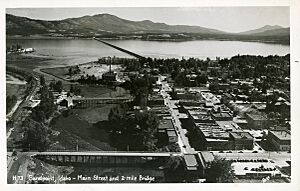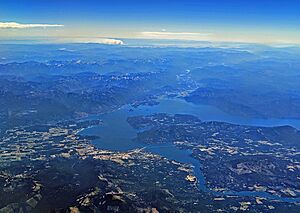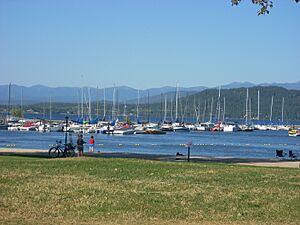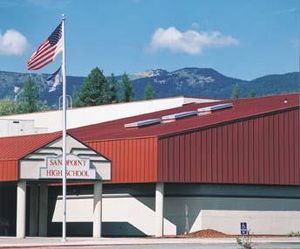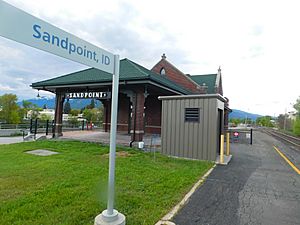Sandpoint, Idaho facts for kids
Quick facts for kids
Sandpoint, Idaho
kamanqukuⱡ
|
|
|---|---|
|
Top row: Cedar Street Bridge Public Market; 2nd row: Sandpoint from Schweitzer Mountain; City Beach; 3rd row: Sandpoint Amtrak Station; Downtown Sandpoint
|
|
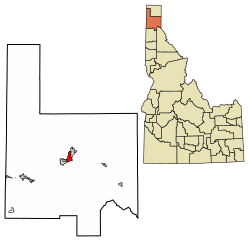
Location of Sandpoint in Bonner County, Idaho.
|
|
| Country | United States |
| State | Idaho |
| County | Bonner |
| Incorporation | 1898 |
| Area | |
| • Total | 4.56 sq mi (11.81 km2) |
| • Land | 4.26 sq mi (11.05 km2) |
| • Water | 0.30 sq mi (0.77 km2) |
| Elevation | 2,113 ft (644 m) |
| Population | |
| • Total | 8,639 |
| • Density | 2,094/sq mi (808.46/km2) |
| Demonym(s) | Sandpointer |
| Time zone | UTC-8 (Pacific (PST)) |
| • Summer (DST) | UTC-7 (PDT) |
| ZIP Code |
83864
|
| Area code(s) | 208, 986 |
| FIPS code | 16-72100 |
| GNIS feature ID | 2411808 |
Sandpoint is the biggest city in Bonner County, Idaho, United States. It is also the county seat, which means it's where the main government offices for the county are located. In 2022, about 9,777 people lived there.
Sandpoint's economy relies on several things. These include products from forests, small factories, and tourism. Many people visit Sandpoint for fun and outdoor activities. It also has many government jobs and a busy shopping area. This is because it's the largest service center for northern Idaho and parts of Montana.
The city sits on the edge of Lake Pend Oreille, Idaho's largest lake, which is 43 miles long. Three big mountain ranges surround Sandpoint: the Selkirk, Cabinet, and Bitterroot ranges. It is home to Schweitzer Mountain Resort, the biggest ski resort in Idaho. Sandpoint is also part of the International Selkirk Loop and two special scenic roads called National Scenic Byways. In 2011, a national survey by Rand McNally and USA Today called Sandpoint the "Most Beautiful Small Town" in the country.
Contents
History of Sandpoint
For many summers, Native American groups like the Kalispel and Kootenai tribes camped by Lake Pend Oreille. They would fish, make baskets from cedar trees, and gather huckleberries. Then, they would return to Montana or Washington in the fall. These summer camps stopped before 1930.
An explorer named David Thompson explored this area a lot starting in 1807. Later, in 1846, a treaty was signed that gave the United States control of the land south of the 49th parallel.
In the 1880s, the Northern Pacific Railroad brought new settlers to the area, including people from Europe and China.
In 1888, a famous person named Theodore Roosevelt, who later became president, visited Sandpoint. He came for a caribou-hunting trip in the Selkirk Mountains. Roosevelt wrote about how wild and rugged Sandpoint was back then.
Sandpoint officially became a city in 1898.
For almost 100 years, cutting down trees (timber harvesting) and railroads were the main ways people made money. Many lumber companies worked in the area from the late 1800s. The Humbird Lumber Company was a very important one. They bought land and built a large mill in Sandpoint. These companies even built their own railroads to move logs. The Great Depression caused many lumber companies, including Humbird, to close.
After the lumber companies, families bought land and slowly cleared the tree stumps. Farming and ranching became important businesses. Then, in the 1950s, people discovered that Lake Pend Oreille was a great place for fishing. During World War II, the economy got a boost from the Farragut Naval Station, a training center for the U.S. Navy on the lake.
In 1963, the Schweitzer Mountain Resort opened. This made Sandpoint a popular place for tourists all year round. People love to visit for water sports, hunting, hiking, horseback riding, fishing, and skiing. This is because of the beautiful Selkirk and Cabinet Mountains and Lake Pend Oreille.
In the 1980s and 1990s, some groups with extreme views settled near Sandpoint. Many Sandpoint residents did not agree with these groups. They formed a group called the Bonner County Human Rights Task Force to stand against them. In 2001, one of these groups lost a lawsuit, which caused them to lose their property and break up. In 2011, Sandpoint became the first city in Idaho to pass a law that protects people from being treated unfairly based on their sexual orientation or gender identity.
Sandpoint has many community events each year. These include the Sandpoint Winter Carnival in February and the Lost in the 50s vintage car show in May. In August, there's the Festival at Sandpoint, a summer music festival. The historic Panida Theater often hosts live shows and independent movies. The Music Conservatory of Sandpoint teaches classical music and opened its "Little Carnegie" concert hall in 2022. Sandpoint is known as a center for arts and culture in northern Idaho.
People have sometimes reported seeing strange lights over Lake Pend Oreille at night. These glowing lights have been thought to be from military activities from the nearby Farragut Naval Training Station, but no one knows for sure what they are.
Geography and Climate
| Weather chart for Sandpoint, Idaho | |||||||||||||||||||||||||||||||||||||||||||||||
|---|---|---|---|---|---|---|---|---|---|---|---|---|---|---|---|---|---|---|---|---|---|---|---|---|---|---|---|---|---|---|---|---|---|---|---|---|---|---|---|---|---|---|---|---|---|---|---|
| J | F | M | A | M | J | J | A | S | O | N | D | ||||||||||||||||||||||||||||||||||||
|
4.9
32
20
|
3.1
38
23
|
2.8
46
28
|
2.1
57
34
|
2.3
66
40
|
2.3
73
46
|
1
82
49
|
1.2
81
47
|
1.7
71
41
|
2.6
57
34
|
4.3
42
28
|
4.6
34
23
|
||||||||||||||||||||||||||||||||||||
| temperatures in °F precipitation totals in inches source: NOAA |
|||||||||||||||||||||||||||||||||||||||||||||||
|
Metric conversion
|
|||||||||||||||||||||||||||||||||||||||||||||||
Sandpoint covers about 4.79 square miles (12.41 square kilometers). Most of this area is land, and about 0.81 square miles (2.10 square kilometers) is water.
Sandpoint has a climate typical of the inland Northwest. Winters are cold and snowy. Summers are dry, with hot days but cool nights. The lowest temperature ever recorded was -37°F (-38°C) in December 1968. The highest was 106°F (41°C) in June 2021. The wettest month was December 1933, and the most snow in one month was 68.8 inches (175 cm) in January 1969.
| Climate data for Sandpoint, Idaho (Sandpoint Experiment Station) (1991–2020 normals, extremes 1910–present) | |||||||||||||
|---|---|---|---|---|---|---|---|---|---|---|---|---|---|
| Month | Jan | Feb | Mar | Apr | May | Jun | Jul | Aug | Sep | Oct | Nov | Dec | Year |
| Record high °F (°C) | 54 (12) |
61 (16) |
71 (22) |
87 (31) |
97 (36) |
106 (41) |
105 (41) |
102 (39) |
96 (36) |
81 (27) |
66 (19) |
58 (14) |
106 (41) |
| Mean maximum °F (°C) | 45.6 (7.6) |
48.3 (9.1) |
60.8 (16.0) |
72.3 (22.4) |
83.6 (28.7) |
88.4 (31.3) |
95.2 (35.1) |
94.8 (34.9) |
86.0 (30.0) |
72.2 (22.3) |
55.3 (12.9) |
45.4 (7.4) |
96.9 (36.1) |
| Mean daily maximum °F (°C) | 33.6 (0.9) |
38.4 (3.6) |
46.4 (8.0) |
55.6 (13.1) |
65.8 (18.8) |
71.8 (22.1) |
81.8 (27.7) |
81.9 (27.7) |
71.7 (22.1) |
56.3 (13.5) |
41.8 (5.4) |
33.5 (0.8) |
56.6 (13.6) |
| Daily mean °F (°C) | 27.8 (−2.3) |
30.6 (−0.8) |
37.5 (3.1) |
45.0 (7.2) |
53.8 (12.1) |
59.6 (15.3) |
66.7 (19.3) |
65.9 (18.8) |
56.5 (13.6) |
47.7 (8.7) |
34.8 (1.6) |
27.6 (−2.4) |
46.1 (7.8) |
| Mean daily minimum °F (°C) | 21.9 (−5.6) |
22.7 (−5.2) |
28.6 (−1.9) |
34.5 (1.4) |
41.8 (5.4) |
47.5 (8.6) |
51.6 (10.9) |
49.8 (9.9) |
41.4 (5.2) |
33.1 (0.6) |
27.9 (−2.3) |
21.8 (−5.7) |
35.2 (1.8) |
| Mean minimum °F (°C) | 2.8 (−16.2) |
7.7 (−13.5) |
13.8 (−10.1) |
24.6 (−4.1) |
30.0 (−1.1) |
36.7 (2.6) |
41.5 (5.3) |
39.9 (4.4) |
30.8 (−0.7) |
21.0 (−6.1) |
14.5 (−9.7) |
6.9 (−13.9) |
−3.1 (−19.5) |
| Record low °F (°C) | −31 (−35) |
−31 (−35) |
−10 (−23) |
9 (−13) |
22 (−6) |
28 (−2) |
33 (1) |
28 (−2) |
16 (−9) |
4 (−16) |
−10 (−23) |
−37 (−38) |
−37 (−38) |
| Average precipitation inches (mm) | 4.33 (110) |
2.91 (74) |
3.58 (91) |
2.37 (60) |
2.72 (69) |
2.44 (62) |
1.17 (30) |
0.80 (20) |
1.41 (36) |
2.95 (75) |
4.72 (120) |
4.61 (117) |
34.01 (864) |
| Average snowfall inches (cm) | 19.2 (49) |
10.1 (26) |
5.7 (14) |
1.5 (3.8) |
0.1 (0.25) |
0.0 (0.0) |
0.0 (0.0) |
0.0 (0.0) |
0.0 (0.0) |
0.0 (0.0) |
6.8 (17) |
19.3 (49) |
62.7 (159.05) |
| Average extreme snow depth inches (cm) | 14.2 (36) |
9.0 (23) |
6.6 (17) |
0.4 (1.0) |
0.0 (0.0) |
0.0 (0.0) |
0.0 (0.0) |
0.0 (0.0) |
0.0 (0.0) |
0.0 (0.0) |
3.5 (8.9) |
10.9 (28) |
19.8 (50) |
| Average precipitation days (≥ 0.01 in) | 15.8 | 12.3 | 13.6 | 11.6 | 11.3 | 10.8 | 5.5 | 4.7 | 7.3 | 11.3 | 14.2 | 15.2 | 133.6 |
| Average snowy days (≥ 0.1 in) | 8.9 | 5.0 | 3.9 | 0.6 | 0.0 | 0.0 | 0.0 | 0.0 | 0.0 | 0.1 | 3.3 | 9.3 | 31.1 |
| Source: NOAA | |||||||||||||
People of Sandpoint
| Historical population | |||
|---|---|---|---|
| Census | Pop. | %± | |
| 1910 | 2,993 | — | |
| 1920 | 2,876 | −3.9% | |
| 1930 | 3,290 | 14.4% | |
| 1940 | 4,356 | 32.4% | |
| 1950 | 4,265 | −2.1% | |
| 1960 | 4,355 | 2.1% | |
| 1970 | 4,144 | −4.8% | |
| 1980 | 4,460 | 7.6% | |
| 1990 | 5,203 | 16.7% | |
| 2000 | 6,835 | 31.4% | |
| 2010 | 7,365 | 7.8% | |
| 2020 | 8,639 | 17.3% | |
| U.S. Decennial Census 2020 | |||
Between 2016 and 2020, the average income for a household in Sandpoint was $46,712. The average income per person was $28,210. About 14.7% of people lived below the poverty line during that time.
The average value of a home owned by its residents was $228,800. About 49.6% of homes were owned by the people living in them between 2006 and 2010.
From 2006 to 2010, about 89.9% of people over 25 years old had finished high school. Also, 25.6% had earned a college degree or higher.
Sandpoint's Population in 2010
In 2010, there were 7,365 people living in Sandpoint. There were 3,215 households and 1,811 families. This means there were about 1,850 people per square mile (714 people per square kilometer). There were also 3,769 homes.
Most of the people in Sandpoint were White (95.5%). A small number were African American (0.1%), Native American (0.7%), or Asian (0.8%). About 2.2% were from two or more races. People of Hispanic or Latino background made up 2.9% of the population.
Out of the 3,215 households, 29.3% had children under 18 living with them. About 39.4% were married couples. In 12.3% of homes, a female head of household lived without a husband. In 4.7% of homes, a male head of household lived without a wife. About 43.7% of households were not families.
About 36.3% of all households were made up of single individuals. In 15.1% of homes, someone aged 65 or older lived alone. The average household had 2.20 people, and the average family had 2.86 people.
The average age in Sandpoint was 38.8 years. About 23.3% of residents were under 18. About 8.1% were between 18 and 24. People aged 25 to 44 made up 26.2%. Those aged 45 to 64 were 25.9%. And 16.7% were 65 years or older. The population was 48.2% male and 51.8% female.
Sandpoint's Economy
Since 2002, Sandpoint has been home to Quest Aircraft, a company that builds airplanes.
Education in Sandpoint
Sandpoint is part of the Lake Pend Oreille School District. Students in grades 9 through 12 attend Sandpoint High School or Lake Pend Oreille Alternative High School. Forrest Bird Charter School teaches students from grades 6 to 12.
Train Travel in Sandpoint
Amtrak's Empire Builder train stops in Sandpoint every day. This train carries passengers between Chicago, Illinois, in the east and Seattle, Washington, and Portland, Oregon, in the west. The Sandpoint Amtrak station is the only train stop in Idaho.
Sandpoint is on the main railway line of the BNSF Railroad. It is about 80 miles northeast of Spokane. In 2023, train travel improved because a second track was added next to a 2.2-mile section, including the bridge over the lake, which used to be only one track.
Local Media
Radio Stations
- KSPT AM 1400 (News/Talk)
- KRFY FM 88.5 (Alternative music)
- KPND FM 95.3 (Adult Hits)
- KTAQ-LP FM 97.7 (3ABN Radio)
- KIBR FM 102.5 (Country music)
- KTPO FM 106.7 (Repeats KPND 95.3)
- FM 105.3 (Sandpoint's Hit Music)
Television Channels
Television stations for Sandpoint come from the Spokane, Washington area:
Newspapers
- The Bonner County Daily Bee, a daily newspaper since 1965.
- The Sandpoint Reader, a weekly newspaper since 2004.
Famous People from Sandpoint
Many notable people have connections to Sandpoint:
- Forrest Bird, an aviator and inventor of medical devices.
- Allie Brosh, a humor writer and blogger.
- Leon Cadore, a baseball pitcher famous for a 26-inning game in 1920. He graduated from Sandpoint High School.
- John Craigie, a folk singer who wrote a song about Sandpoint.
- James C. Fry, a U.S. Army major general.
- Mark Fuhrman, a former police detective.
- Tinker Hatfield, a famous athletic shoe designer for Nike.
- Nate Holland, an Olympian and X Games gold medalist in snowboarding.
- Nell Kruegel Irion, a city councilor and the first woman to run for Congress in Idaho.
- Jerry Kramer, a football player and author.
- Joe Mather, a Major League Baseball outfielder.
- Patrick F. McManus, an outdoor writer and humorist.
- Viggo Mortensen, a well-known actor and producer.
- Alex R. Munson, a chief judge.
- Don Osborn, a former baseball pitcher and coach.
- Kristy Osmunson, a singer and fiddle player.
- Sarah Palin, a former governor of Alaska.
- Genevieve Pezet, an American artist.
- Jake Plummer, a former NFL quarterback.
- Shook Twins, a folk music duo who grew up in Sandpoint.
- Lucy Ann Polk, a big-band singer.
- Marilynne Robinson, a writer who won a Pulitzer Prize.
- Jake Rosholt, a mixed martial artist and wrestler.
- Don Samuelson, a former Governor of Idaho.
- Edgar Steele, an attorney.
- Ben Stein, a writer, lawyer, actor, and commentator.
- Tim Thomas, a retired National Hockey League goalie.
See also
 In Spanish: Sandpoint para niños
In Spanish: Sandpoint para niños






